Financial Management Report: Squeezeco and Lovewell Analysis
VerifiedAdded on 2023/01/09
|14
|3914
|27
Report
AI Summary
This report delves into key aspects of financial management, focusing on dividend policy and investment appraisal techniques. It begins by analyzing Squeezeco's dividend options, including cash dividends, scrip dividends, and share repurchase, calculating their impact on shareholder wealth. The report then explores the influence of a positive Net Present Value (NPV) project on a company's investment decisions. Furthermore, it examines various investment appraisal techniques, such as payback period, accounting rate of return (ARR), net present value (NPV), and internal rate of return (IRR), providing detailed calculations and critical evaluations of their benefits and limitations. The report concludes with recommendations for investment decisions based on the analysis of these techniques, offering a comprehensive overview of financial management principles and their practical application.

Financial
Management
Management
Paraphrase This Document
Need a fresh take? Get an instant paraphrase of this document with our AI Paraphraser
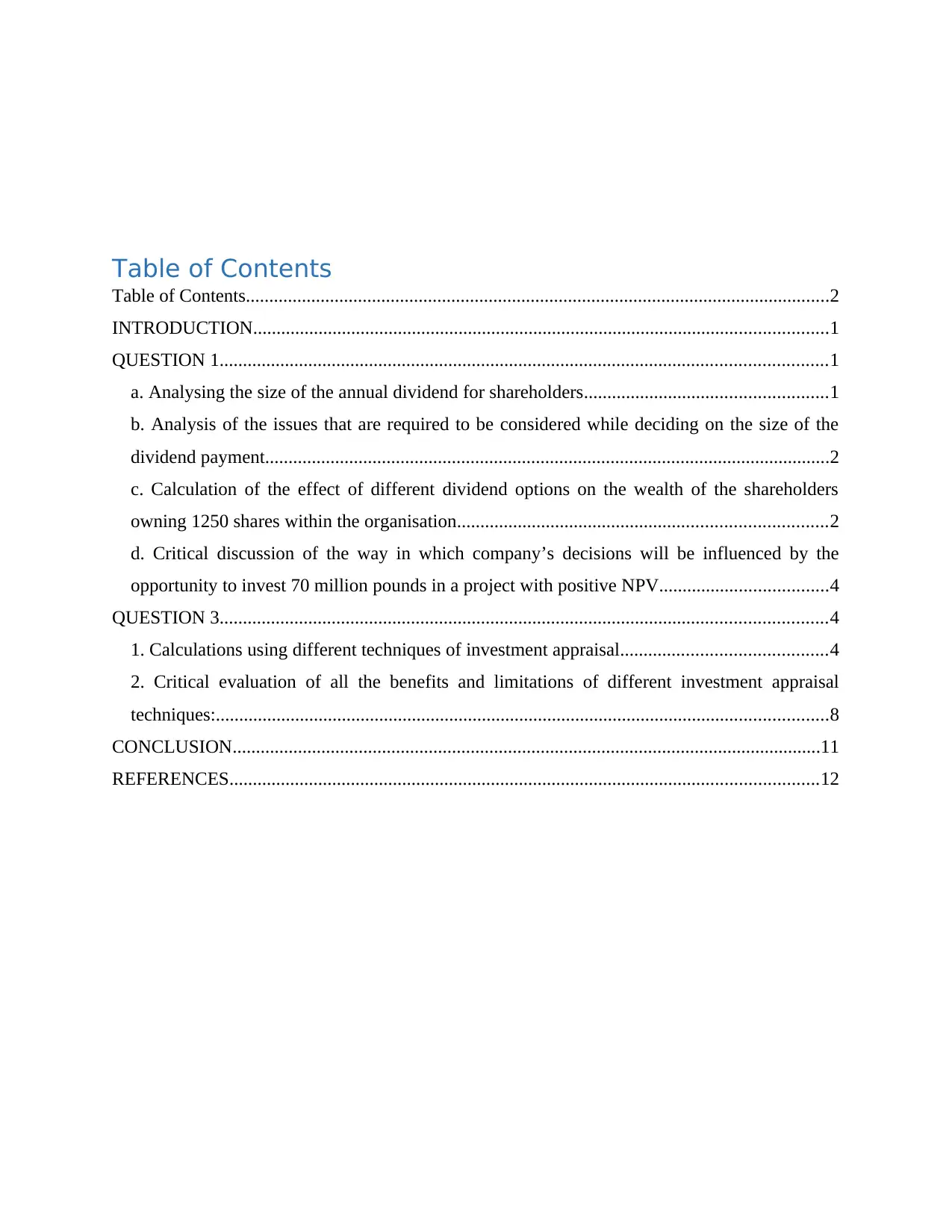
Table of Contents
Table of Contents.............................................................................................................................2
INTRODUCTION...........................................................................................................................1
QUESTION 1..................................................................................................................................1
a. Analysing the size of the annual dividend for shareholders....................................................1
b. Analysis of the issues that are required to be considered while deciding on the size of the
dividend payment.........................................................................................................................2
c. Calculation of the effect of different dividend options on the wealth of the shareholders
owning 1250 shares within the organisation...............................................................................2
d. Critical discussion of the way in which company’s decisions will be influenced by the
opportunity to invest 70 million pounds in a project with positive NPV....................................4
QUESTION 3..................................................................................................................................4
1. Calculations using different techniques of investment appraisal............................................4
2. Critical evaluation of all the benefits and limitations of different investment appraisal
techniques:...................................................................................................................................8
CONCLUSION..............................................................................................................................11
REFERENCES..............................................................................................................................12
Table of Contents.............................................................................................................................2
INTRODUCTION...........................................................................................................................1
QUESTION 1..................................................................................................................................1
a. Analysing the size of the annual dividend for shareholders....................................................1
b. Analysis of the issues that are required to be considered while deciding on the size of the
dividend payment.........................................................................................................................2
c. Calculation of the effect of different dividend options on the wealth of the shareholders
owning 1250 shares within the organisation...............................................................................2
d. Critical discussion of the way in which company’s decisions will be influenced by the
opportunity to invest 70 million pounds in a project with positive NPV....................................4
QUESTION 3..................................................................................................................................4
1. Calculations using different techniques of investment appraisal............................................4
2. Critical evaluation of all the benefits and limitations of different investment appraisal
techniques:...................................................................................................................................8
CONCLUSION..............................................................................................................................11
REFERENCES..............................................................................................................................12
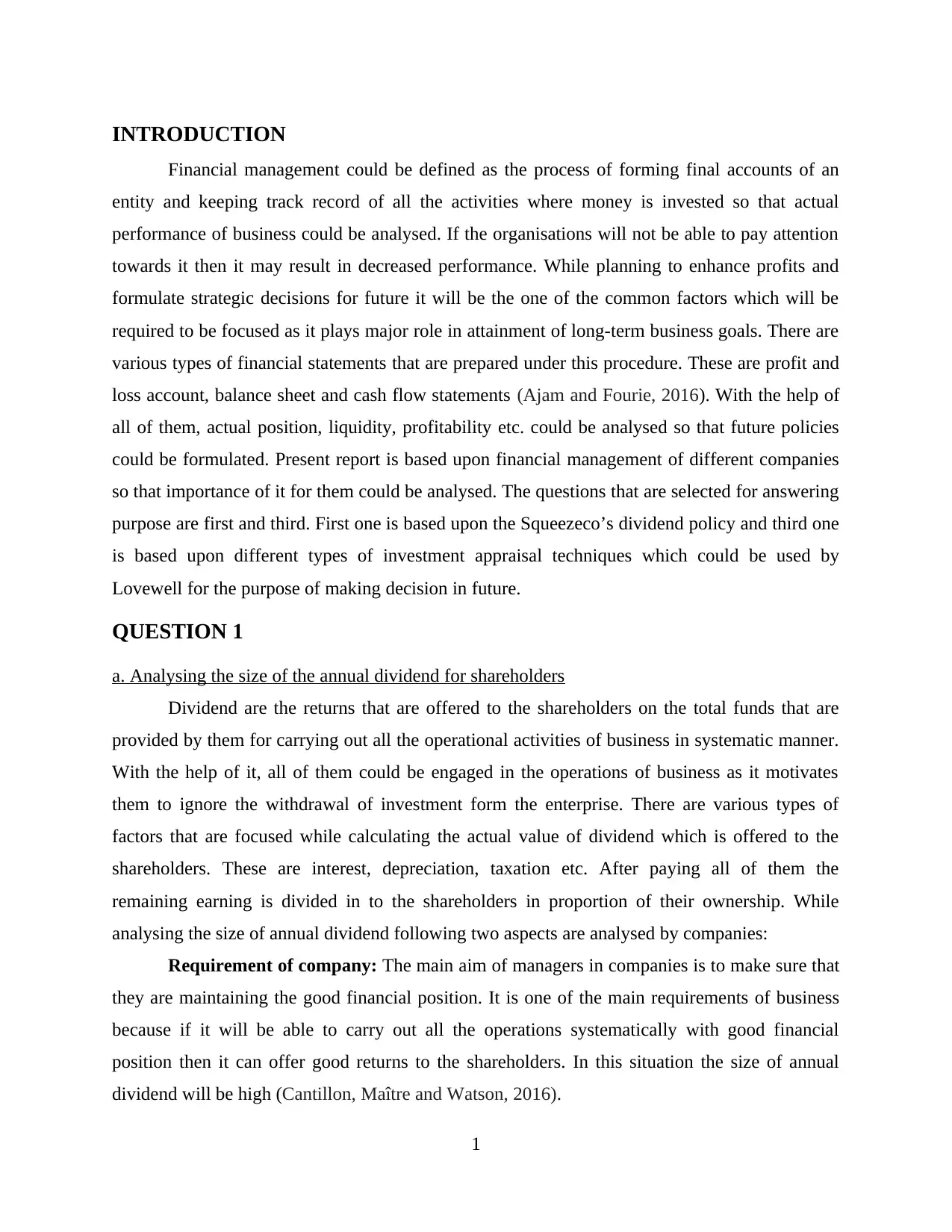
INTRODUCTION
Financial management could be defined as the process of forming final accounts of an
entity and keeping track record of all the activities where money is invested so that actual
performance of business could be analysed. If the organisations will not be able to pay attention
towards it then it may result in decreased performance. While planning to enhance profits and
formulate strategic decisions for future it will be the one of the common factors which will be
required to be focused as it plays major role in attainment of long-term business goals. There are
various types of financial statements that are prepared under this procedure. These are profit and
loss account, balance sheet and cash flow statements (Ajam and Fourie, 2016). With the help of
all of them, actual position, liquidity, profitability etc. could be analysed so that future policies
could be formulated. Present report is based upon financial management of different companies
so that importance of it for them could be analysed. The questions that are selected for answering
purpose are first and third. First one is based upon the Squeezeco’s dividend policy and third one
is based upon different types of investment appraisal techniques which could be used by
Lovewell for the purpose of making decision in future.
QUESTION 1
a. Analysing the size of the annual dividend for shareholders
Dividend are the returns that are offered to the shareholders on the total funds that are
provided by them for carrying out all the operational activities of business in systematic manner.
With the help of it, all of them could be engaged in the operations of business as it motivates
them to ignore the withdrawal of investment form the enterprise. There are various types of
factors that are focused while calculating the actual value of dividend which is offered to the
shareholders. These are interest, depreciation, taxation etc. After paying all of them the
remaining earning is divided in to the shareholders in proportion of their ownership. While
analysing the size of annual dividend following two aspects are analysed by companies:
Requirement of company: The main aim of managers in companies is to make sure that
they are maintaining the good financial position. It is one of the main requirements of business
because if it will be able to carry out all the operations systematically with good financial
position then it can offer good returns to the shareholders. In this situation the size of annual
dividend will be high (Cantillon, Maître and Watson, 2016).
1
Financial management could be defined as the process of forming final accounts of an
entity and keeping track record of all the activities where money is invested so that actual
performance of business could be analysed. If the organisations will not be able to pay attention
towards it then it may result in decreased performance. While planning to enhance profits and
formulate strategic decisions for future it will be the one of the common factors which will be
required to be focused as it plays major role in attainment of long-term business goals. There are
various types of financial statements that are prepared under this procedure. These are profit and
loss account, balance sheet and cash flow statements (Ajam and Fourie, 2016). With the help of
all of them, actual position, liquidity, profitability etc. could be analysed so that future policies
could be formulated. Present report is based upon financial management of different companies
so that importance of it for them could be analysed. The questions that are selected for answering
purpose are first and third. First one is based upon the Squeezeco’s dividend policy and third one
is based upon different types of investment appraisal techniques which could be used by
Lovewell for the purpose of making decision in future.
QUESTION 1
a. Analysing the size of the annual dividend for shareholders
Dividend are the returns that are offered to the shareholders on the total funds that are
provided by them for carrying out all the operational activities of business in systematic manner.
With the help of it, all of them could be engaged in the operations of business as it motivates
them to ignore the withdrawal of investment form the enterprise. There are various types of
factors that are focused while calculating the actual value of dividend which is offered to the
shareholders. These are interest, depreciation, taxation etc. After paying all of them the
remaining earning is divided in to the shareholders in proportion of their ownership. While
analysing the size of annual dividend following two aspects are analysed by companies:
Requirement of company: The main aim of managers in companies is to make sure that
they are maintaining the good financial position. It is one of the main requirements of business
because if it will be able to carry out all the operations systematically with good financial
position then it can offer good returns to the shareholders. In this situation the size of annual
dividend will be high (Cantillon, Maître and Watson, 2016).
1
⊘ This is a preview!⊘
Do you want full access?
Subscribe today to unlock all pages.

Trusted by 1+ million students worldwide
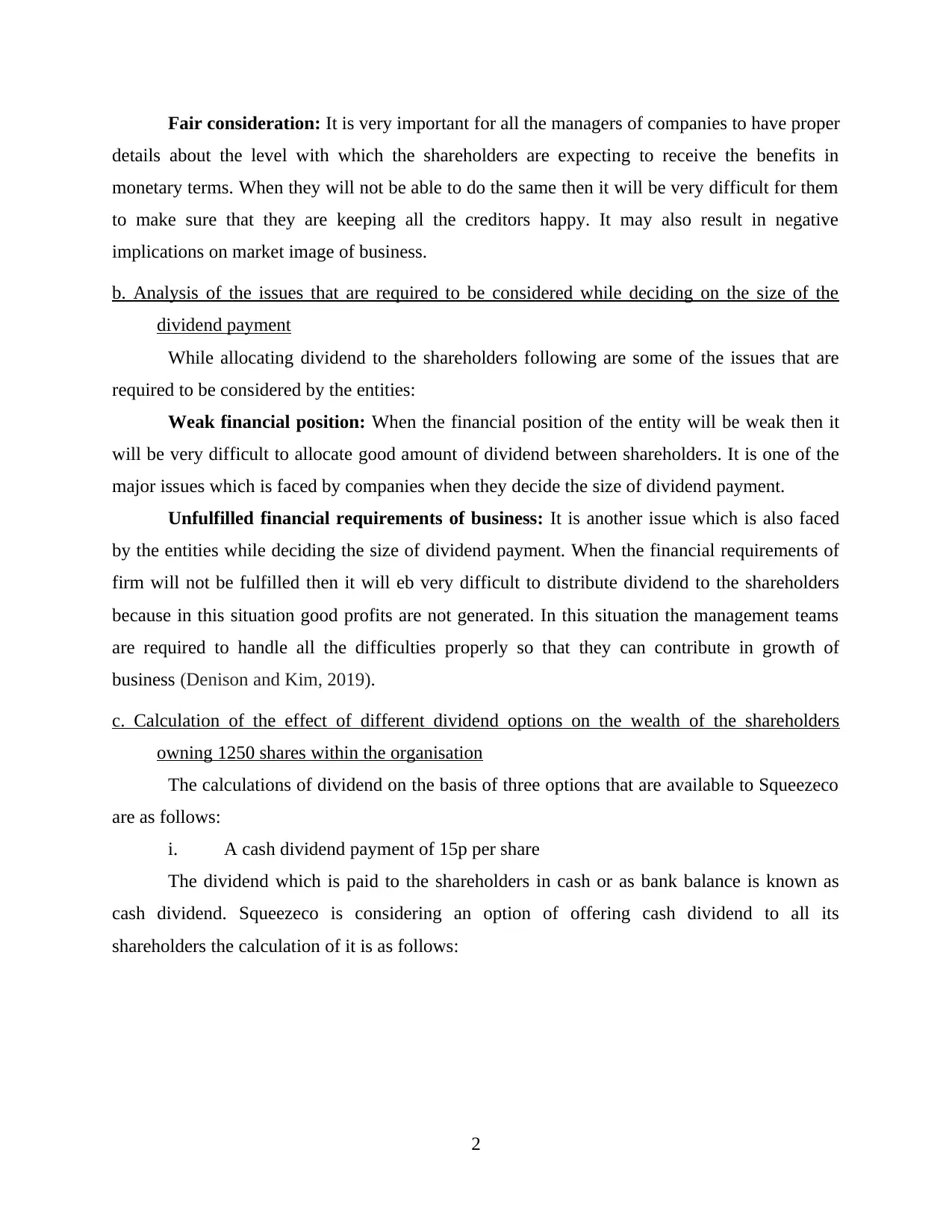
Fair consideration: It is very important for all the managers of companies to have proper
details about the level with which the shareholders are expecting to receive the benefits in
monetary terms. When they will not be able to do the same then it will be very difficult for them
to make sure that they are keeping all the creditors happy. It may also result in negative
implications on market image of business.
b. Analysis of the issues that are required to be considered while deciding on the size of the
dividend payment
While allocating dividend to the shareholders following are some of the issues that are
required to be considered by the entities:
Weak financial position: When the financial position of the entity will be weak then it
will be very difficult to allocate good amount of dividend between shareholders. It is one of the
major issues which is faced by companies when they decide the size of dividend payment.
Unfulfilled financial requirements of business: It is another issue which is also faced
by the entities while deciding the size of dividend payment. When the financial requirements of
firm will not be fulfilled then it will eb very difficult to distribute dividend to the shareholders
because in this situation good profits are not generated. In this situation the management teams
are required to handle all the difficulties properly so that they can contribute in growth of
business (Denison and Kim, 2019).
c. Calculation of the effect of different dividend options on the wealth of the shareholders
owning 1250 shares within the organisation
The calculations of dividend on the basis of three options that are available to Squeezeco
are as follows:
i. A cash dividend payment of 15p per share
The dividend which is paid to the shareholders in cash or as bank balance is known as
cash dividend. Squeezeco is considering an option of offering cash dividend to all its
shareholders the calculation of it is as follows:
2
details about the level with which the shareholders are expecting to receive the benefits in
monetary terms. When they will not be able to do the same then it will be very difficult for them
to make sure that they are keeping all the creditors happy. It may also result in negative
implications on market image of business.
b. Analysis of the issues that are required to be considered while deciding on the size of the
dividend payment
While allocating dividend to the shareholders following are some of the issues that are
required to be considered by the entities:
Weak financial position: When the financial position of the entity will be weak then it
will be very difficult to allocate good amount of dividend between shareholders. It is one of the
major issues which is faced by companies when they decide the size of dividend payment.
Unfulfilled financial requirements of business: It is another issue which is also faced
by the entities while deciding the size of dividend payment. When the financial requirements of
firm will not be fulfilled then it will eb very difficult to distribute dividend to the shareholders
because in this situation good profits are not generated. In this situation the management teams
are required to handle all the difficulties properly so that they can contribute in growth of
business (Denison and Kim, 2019).
c. Calculation of the effect of different dividend options on the wealth of the shareholders
owning 1250 shares within the organisation
The calculations of dividend on the basis of three options that are available to Squeezeco
are as follows:
i. A cash dividend payment of 15p per share
The dividend which is paid to the shareholders in cash or as bank balance is known as
cash dividend. Squeezeco is considering an option of offering cash dividend to all its
shareholders the calculation of it is as follows:
2
Paraphrase This Document
Need a fresh take? Get an instant paraphrase of this document with our AI Paraphraser
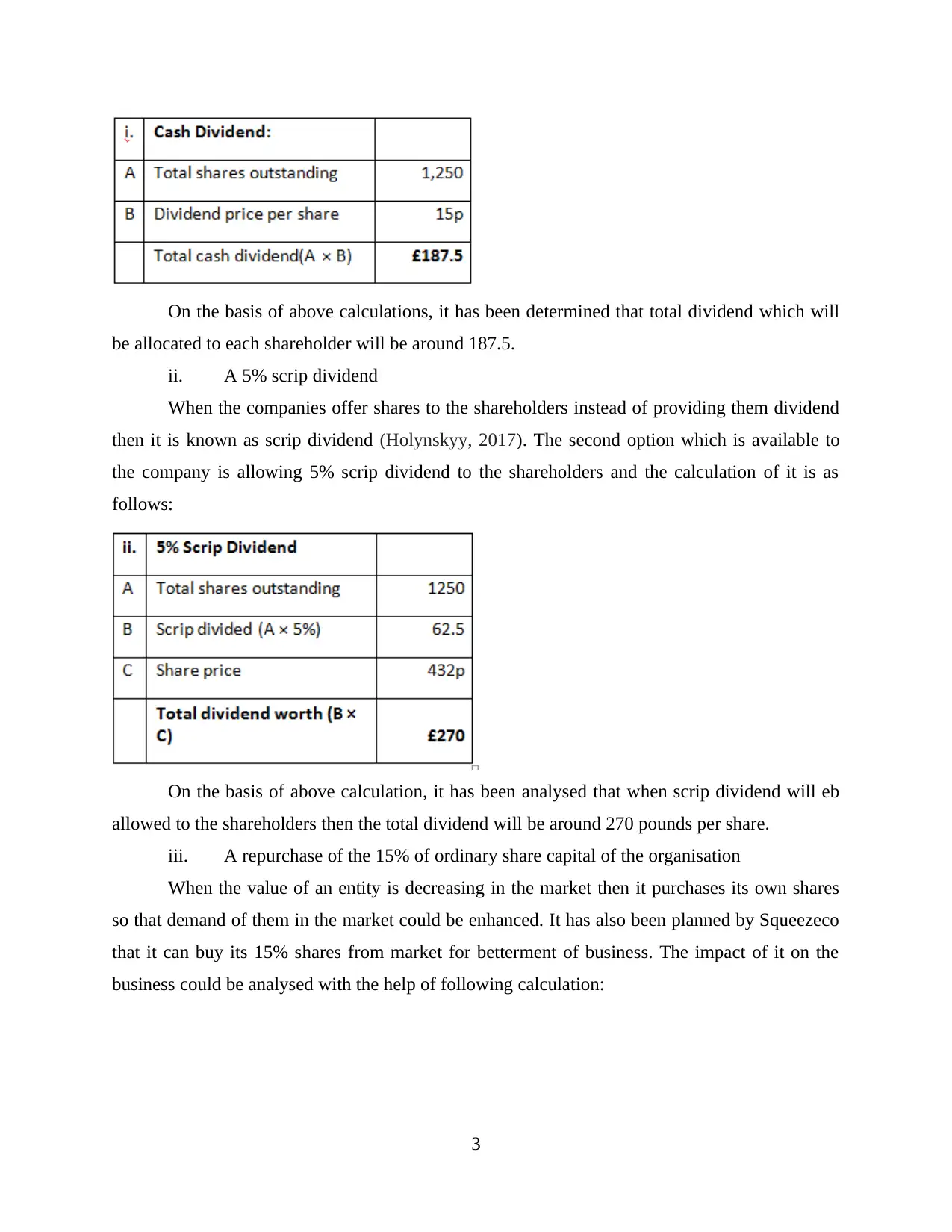
On the basis of above calculations, it has been determined that total dividend which will
be allocated to each shareholder will be around 187.5.
ii. A 5% scrip dividend
When the companies offer shares to the shareholders instead of providing them dividend
then it is known as scrip dividend (Holynskyy, 2017). The second option which is available to
the company is allowing 5% scrip dividend to the shareholders and the calculation of it is as
follows:
On the basis of above calculation, it has been analysed that when scrip dividend will eb
allowed to the shareholders then the total dividend will be around 270 pounds per share.
iii. A repurchase of the 15% of ordinary share capital of the organisation
When the value of an entity is decreasing in the market then it purchases its own shares
so that demand of them in the market could be enhanced. It has also been planned by Squeezeco
that it can buy its 15% shares from market for betterment of business. The impact of it on the
business could be analysed with the help of following calculation:
3
be allocated to each shareholder will be around 187.5.
ii. A 5% scrip dividend
When the companies offer shares to the shareholders instead of providing them dividend
then it is known as scrip dividend (Holynskyy, 2017). The second option which is available to
the company is allowing 5% scrip dividend to the shareholders and the calculation of it is as
follows:
On the basis of above calculation, it has been analysed that when scrip dividend will eb
allowed to the shareholders then the total dividend will be around 270 pounds per share.
iii. A repurchase of the 15% of ordinary share capital of the organisation
When the value of an entity is decreasing in the market then it purchases its own shares
so that demand of them in the market could be enhanced. It has also been planned by Squeezeco
that it can buy its 15% shares from market for betterment of business. The impact of it on the
business could be analysed with the help of following calculation:
3
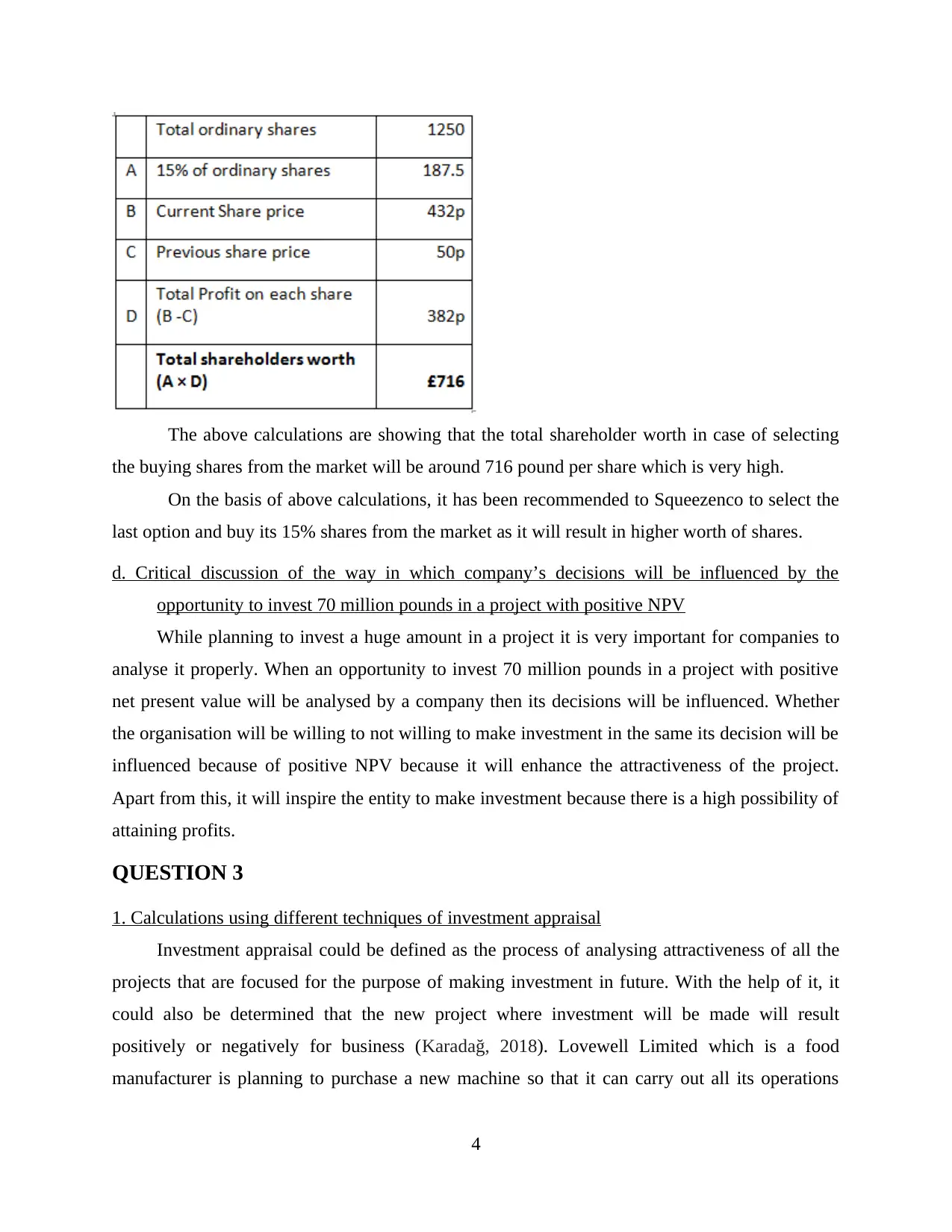
The above calculations are showing that the total shareholder worth in case of selecting
the buying shares from the market will be around 716 pound per share which is very high.
On the basis of above calculations, it has been recommended to Squeezenco to select the
last option and buy its 15% shares from the market as it will result in higher worth of shares.
d. Critical discussion of the way in which company’s decisions will be influenced by the
opportunity to invest 70 million pounds in a project with positive NPV
While planning to invest a huge amount in a project it is very important for companies to
analyse it properly. When an opportunity to invest 70 million pounds in a project with positive
net present value will be analysed by a company then its decisions will be influenced. Whether
the organisation will be willing to not willing to make investment in the same its decision will be
influenced because of positive NPV because it will enhance the attractiveness of the project.
Apart from this, it will inspire the entity to make investment because there is a high possibility of
attaining profits.
QUESTION 3
1. Calculations using different techniques of investment appraisal
Investment appraisal could be defined as the process of analysing attractiveness of all the
projects that are focused for the purpose of making investment in future. With the help of it, it
could also be determined that the new project where investment will be made will result
positively or negatively for business (Karadağ, 2018). Lovewell Limited which is a food
manufacturer is planning to purchase a new machine so that it can carry out all its operations
4
the buying shares from the market will be around 716 pound per share which is very high.
On the basis of above calculations, it has been recommended to Squeezenco to select the
last option and buy its 15% shares from the market as it will result in higher worth of shares.
d. Critical discussion of the way in which company’s decisions will be influenced by the
opportunity to invest 70 million pounds in a project with positive NPV
While planning to invest a huge amount in a project it is very important for companies to
analyse it properly. When an opportunity to invest 70 million pounds in a project with positive
net present value will be analysed by a company then its decisions will be influenced. Whether
the organisation will be willing to not willing to make investment in the same its decision will be
influenced because of positive NPV because it will enhance the attractiveness of the project.
Apart from this, it will inspire the entity to make investment because there is a high possibility of
attaining profits.
QUESTION 3
1. Calculations using different techniques of investment appraisal
Investment appraisal could be defined as the process of analysing attractiveness of all the
projects that are focused for the purpose of making investment in future. With the help of it, it
could also be determined that the new project where investment will be made will result
positively or negatively for business (Karadağ, 2018). Lovewell Limited which is a food
manufacturer is planning to purchase a new machine so that it can carry out all its operations
4
⊘ This is a preview!⊘
Do you want full access?
Subscribe today to unlock all pages.

Trusted by 1+ million students worldwide
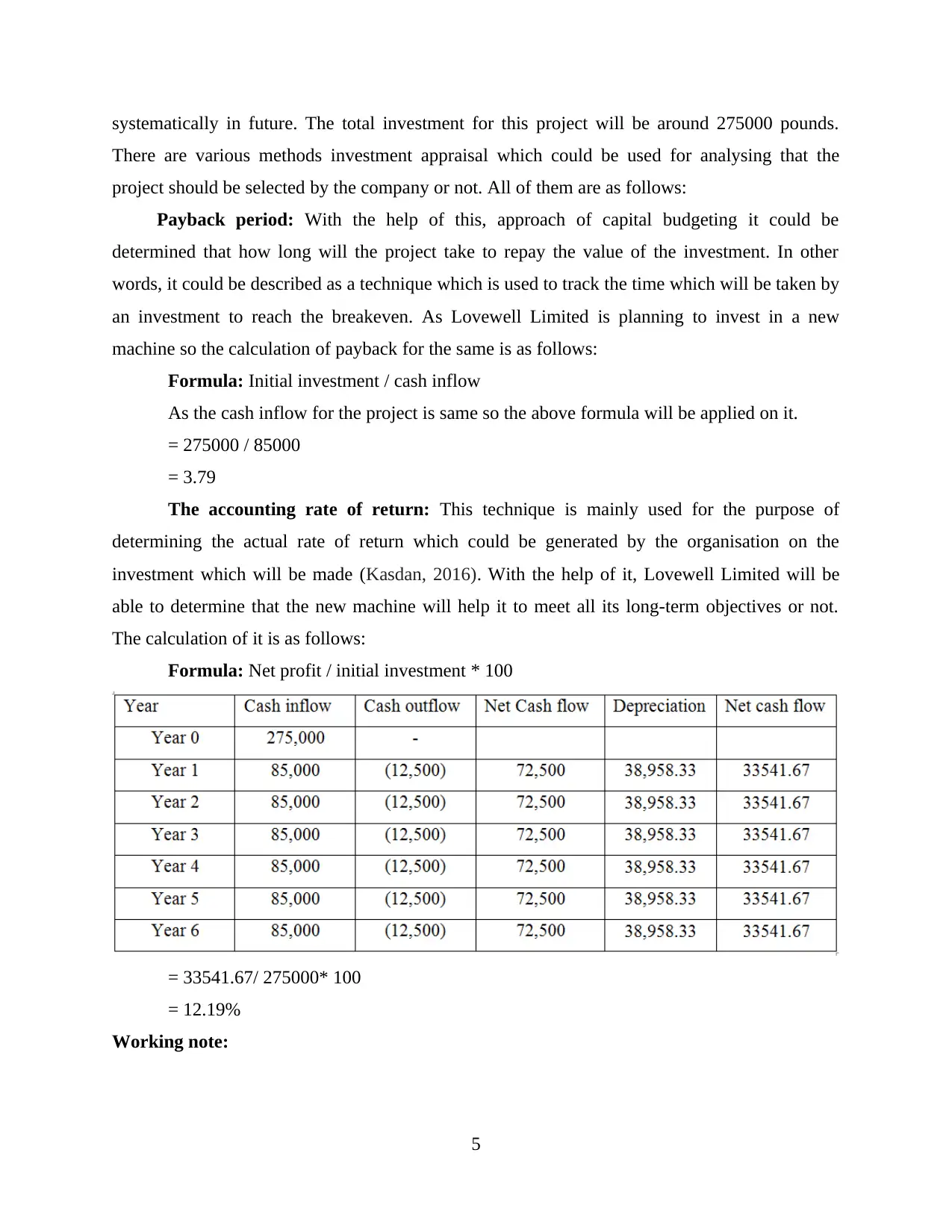
systematically in future. The total investment for this project will be around 275000 pounds.
There are various methods investment appraisal which could be used for analysing that the
project should be selected by the company or not. All of them are as follows:
Payback period: With the help of this, approach of capital budgeting it could be
determined that how long will the project take to repay the value of the investment. In other
words, it could be described as a technique which is used to track the time which will be taken by
an investment to reach the breakeven. As Lovewell Limited is planning to invest in a new
machine so the calculation of payback for the same is as follows:
Formula: Initial investment / cash inflow
As the cash inflow for the project is same so the above formula will be applied on it.
= 275000 / 85000
= 3.79
The accounting rate of return: This technique is mainly used for the purpose of
determining the actual rate of return which could be generated by the organisation on the
investment which will be made (Kasdan, 2016). With the help of it, Lovewell Limited will be
able to determine that the new machine will help it to meet all its long-term objectives or not.
The calculation of it is as follows:
Formula: Net profit / initial investment * 100
= 33541.67/ 275000* 100
= 12.19%
Working note:
5
There are various methods investment appraisal which could be used for analysing that the
project should be selected by the company or not. All of them are as follows:
Payback period: With the help of this, approach of capital budgeting it could be
determined that how long will the project take to repay the value of the investment. In other
words, it could be described as a technique which is used to track the time which will be taken by
an investment to reach the breakeven. As Lovewell Limited is planning to invest in a new
machine so the calculation of payback for the same is as follows:
Formula: Initial investment / cash inflow
As the cash inflow for the project is same so the above formula will be applied on it.
= 275000 / 85000
= 3.79
The accounting rate of return: This technique is mainly used for the purpose of
determining the actual rate of return which could be generated by the organisation on the
investment which will be made (Kasdan, 2016). With the help of it, Lovewell Limited will be
able to determine that the new machine will help it to meet all its long-term objectives or not.
The calculation of it is as follows:
Formula: Net profit / initial investment * 100
= 33541.67/ 275000* 100
= 12.19%
Working note:
5
Paraphrase This Document
Need a fresh take? Get an instant paraphrase of this document with our AI Paraphraser
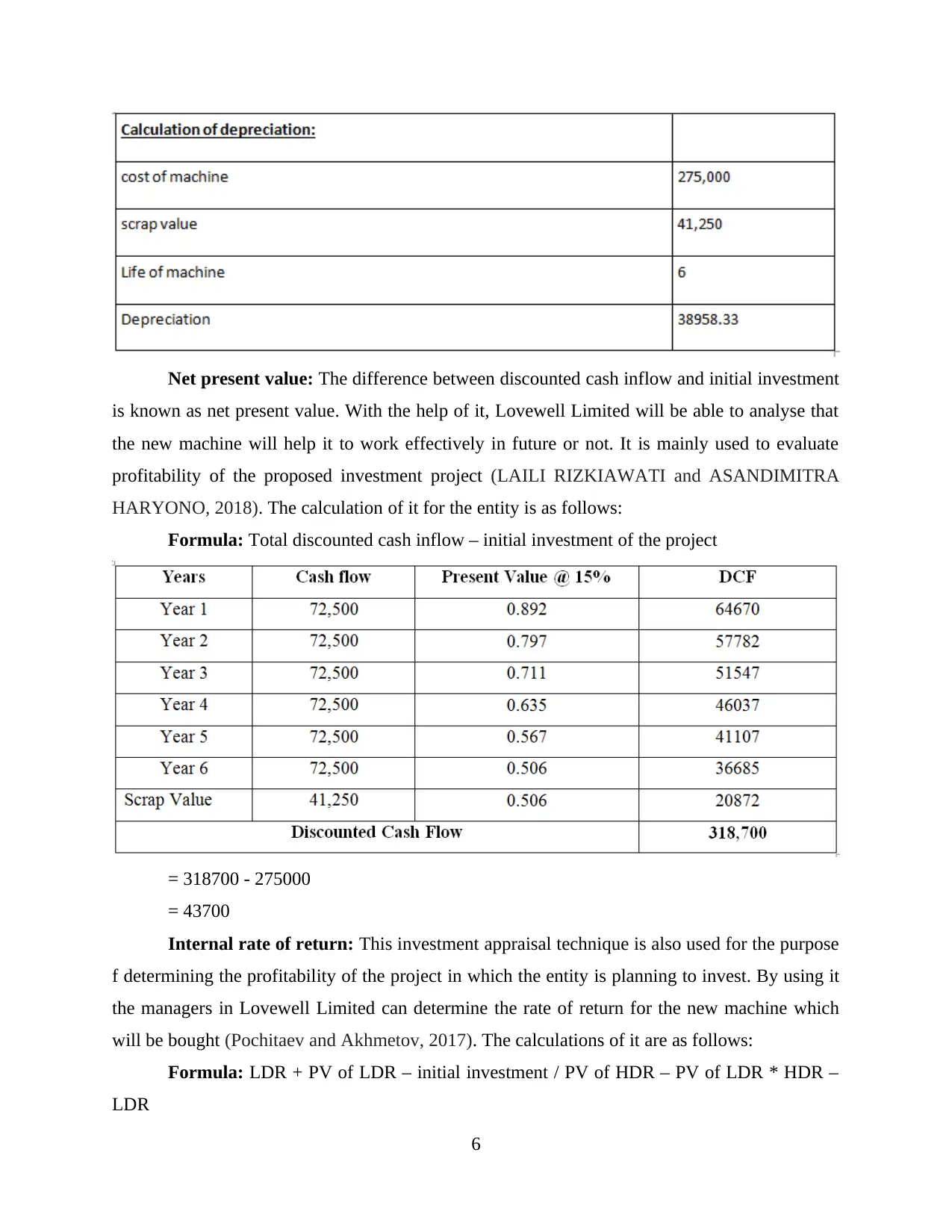
Net present value: The difference between discounted cash inflow and initial investment
is known as net present value. With the help of it, Lovewell Limited will be able to analyse that
the new machine will help it to work effectively in future or not. It is mainly used to evaluate
profitability of the proposed investment project (LAILI RIZKIAWATI and ASANDIMITRA
HARYONO, 2018). The calculation of it for the entity is as follows:
Formula: Total discounted cash inflow – initial investment of the project
= 318700 - 275000
= 43700
Internal rate of return: This investment appraisal technique is also used for the purpose
f determining the profitability of the project in which the entity is planning to invest. By using it
the managers in Lovewell Limited can determine the rate of return for the new machine which
will be bought (Pochitaev and Akhmetov, 2017). The calculations of it are as follows:
Formula: LDR + PV of LDR – initial investment / PV of HDR – PV of LDR * HDR –
LDR
6
is known as net present value. With the help of it, Lovewell Limited will be able to analyse that
the new machine will help it to work effectively in future or not. It is mainly used to evaluate
profitability of the proposed investment project (LAILI RIZKIAWATI and ASANDIMITRA
HARYONO, 2018). The calculation of it for the entity is as follows:
Formula: Total discounted cash inflow – initial investment of the project
= 318700 - 275000
= 43700
Internal rate of return: This investment appraisal technique is also used for the purpose
f determining the profitability of the project in which the entity is planning to invest. By using it
the managers in Lovewell Limited can determine the rate of return for the new machine which
will be bought (Pochitaev and Akhmetov, 2017). The calculations of it are as follows:
Formula: LDR + PV of LDR – initial investment / PV of HDR – PV of LDR * HDR –
LDR
6
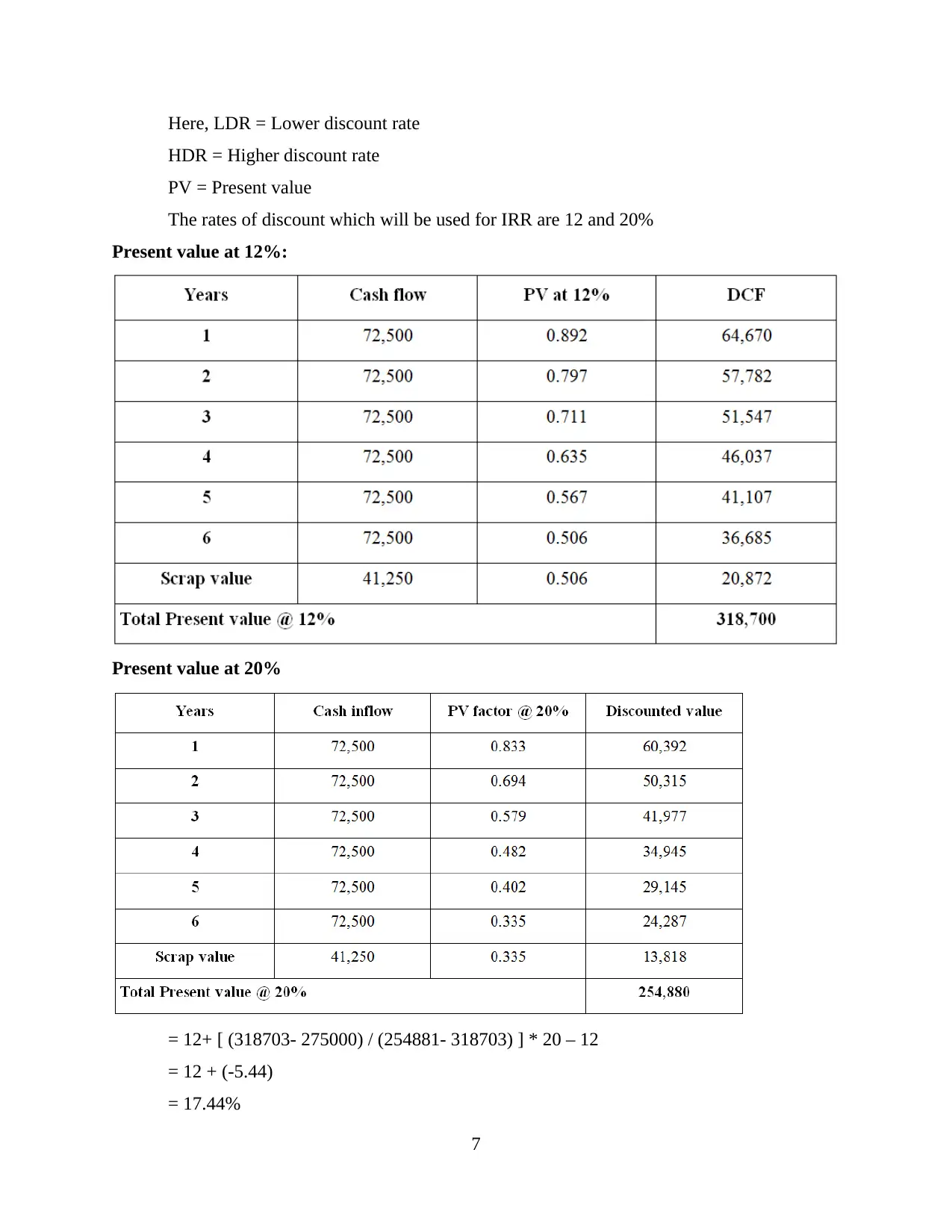
Here, LDR = Lower discount rate
HDR = Higher discount rate
PV = Present value
The rates of discount which will be used for IRR are 12 and 20%
Present value at 12%:
Present value at 20%
= 12+ [ (318703- 275000) / (254881- 318703) ] * 20 – 12
= 12 + (-5.44)
= 17.44%
7
HDR = Higher discount rate
PV = Present value
The rates of discount which will be used for IRR are 12 and 20%
Present value at 12%:
Present value at 20%
= 12+ [ (318703- 275000) / (254881- 318703) ] * 20 – 12
= 12 + (-5.44)
= 17.44%
7
⊘ This is a preview!⊘
Do you want full access?
Subscribe today to unlock all pages.

Trusted by 1+ million students worldwide
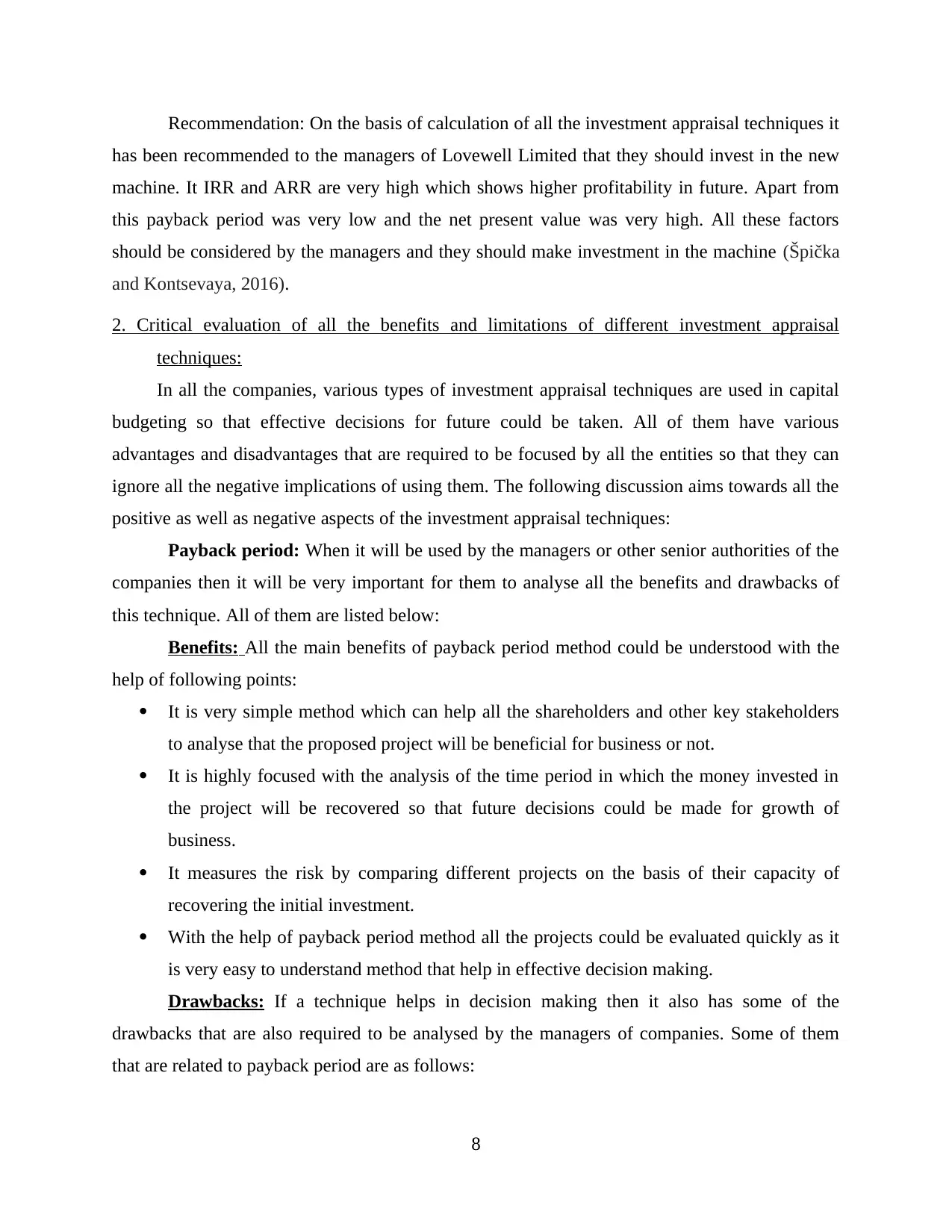
Recommendation: On the basis of calculation of all the investment appraisal techniques it
has been recommended to the managers of Lovewell Limited that they should invest in the new
machine. It IRR and ARR are very high which shows higher profitability in future. Apart from
this payback period was very low and the net present value was very high. All these factors
should be considered by the managers and they should make investment in the machine (Špička
and Kontsevaya, 2016).
2. Critical evaluation of all the benefits and limitations of different investment appraisal
techniques:
In all the companies, various types of investment appraisal techniques are used in capital
budgeting so that effective decisions for future could be taken. All of them have various
advantages and disadvantages that are required to be focused by all the entities so that they can
ignore all the negative implications of using them. The following discussion aims towards all the
positive as well as negative aspects of the investment appraisal techniques:
Payback period: When it will be used by the managers or other senior authorities of the
companies then it will be very important for them to analyse all the benefits and drawbacks of
this technique. All of them are listed below:
Benefits: All the main benefits of payback period method could be understood with the
help of following points:
It is very simple method which can help all the shareholders and other key stakeholders
to analyse that the proposed project will be beneficial for business or not.
It is highly focused with the analysis of the time period in which the money invested in
the project will be recovered so that future decisions could be made for growth of
business.
It measures the risk by comparing different projects on the basis of their capacity of
recovering the initial investment.
With the help of payback period method all the projects could be evaluated quickly as it
is very easy to understand method that help in effective decision making.
Drawbacks: If a technique helps in decision making then it also has some of the
drawbacks that are also required to be analysed by the managers of companies. Some of them
that are related to payback period are as follows:
8
has been recommended to the managers of Lovewell Limited that they should invest in the new
machine. It IRR and ARR are very high which shows higher profitability in future. Apart from
this payback period was very low and the net present value was very high. All these factors
should be considered by the managers and they should make investment in the machine (Špička
and Kontsevaya, 2016).
2. Critical evaluation of all the benefits and limitations of different investment appraisal
techniques:
In all the companies, various types of investment appraisal techniques are used in capital
budgeting so that effective decisions for future could be taken. All of them have various
advantages and disadvantages that are required to be focused by all the entities so that they can
ignore all the negative implications of using them. The following discussion aims towards all the
positive as well as negative aspects of the investment appraisal techniques:
Payback period: When it will be used by the managers or other senior authorities of the
companies then it will be very important for them to analyse all the benefits and drawbacks of
this technique. All of them are listed below:
Benefits: All the main benefits of payback period method could be understood with the
help of following points:
It is very simple method which can help all the shareholders and other key stakeholders
to analyse that the proposed project will be beneficial for business or not.
It is highly focused with the analysis of the time period in which the money invested in
the project will be recovered so that future decisions could be made for growth of
business.
It measures the risk by comparing different projects on the basis of their capacity of
recovering the initial investment.
With the help of payback period method all the projects could be evaluated quickly as it
is very easy to understand method that help in effective decision making.
Drawbacks: If a technique helps in decision making then it also has some of the
drawbacks that are also required to be analysed by the managers of companies. Some of them
that are related to payback period are as follows:
8
Paraphrase This Document
Need a fresh take? Get an instant paraphrase of this document with our AI Paraphraser
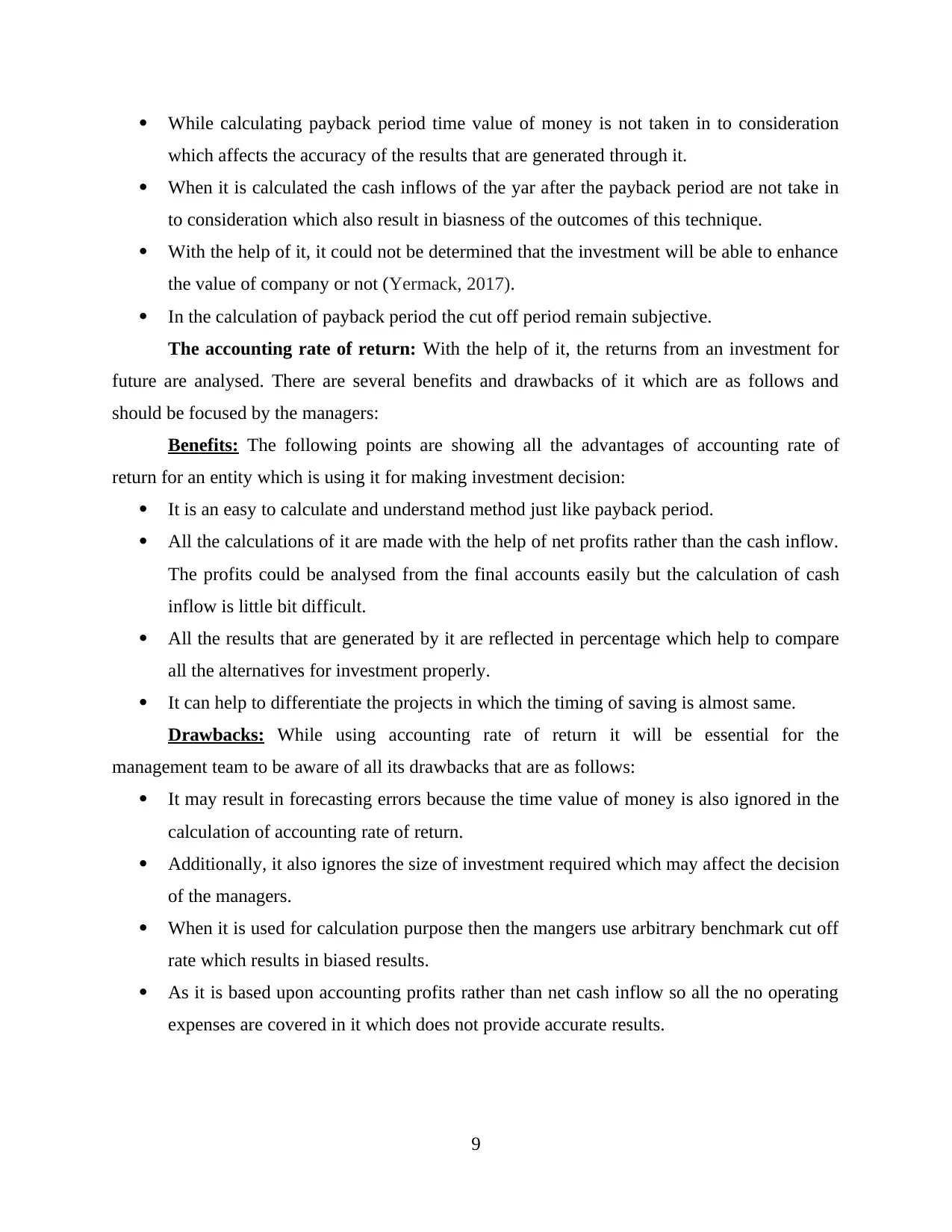
While calculating payback period time value of money is not taken in to consideration
which affects the accuracy of the results that are generated through it.
When it is calculated the cash inflows of the yar after the payback period are not take in
to consideration which also result in biasness of the outcomes of this technique.
With the help of it, it could not be determined that the investment will be able to enhance
the value of company or not (Yermack, 2017).
In the calculation of payback period the cut off period remain subjective.
The accounting rate of return: With the help of it, the returns from an investment for
future are analysed. There are several benefits and drawbacks of it which are as follows and
should be focused by the managers:
Benefits: The following points are showing all the advantages of accounting rate of
return for an entity which is using it for making investment decision:
It is an easy to calculate and understand method just like payback period.
All the calculations of it are made with the help of net profits rather than the cash inflow.
The profits could be analysed from the final accounts easily but the calculation of cash
inflow is little bit difficult.
All the results that are generated by it are reflected in percentage which help to compare
all the alternatives for investment properly.
It can help to differentiate the projects in which the timing of saving is almost same.
Drawbacks: While using accounting rate of return it will be essential for the
management team to be aware of all its drawbacks that are as follows:
It may result in forecasting errors because the time value of money is also ignored in the
calculation of accounting rate of return.
Additionally, it also ignores the size of investment required which may affect the decision
of the managers.
When it is used for calculation purpose then the mangers use arbitrary benchmark cut off
rate which results in biased results.
As it is based upon accounting profits rather than net cash inflow so all the no operating
expenses are covered in it which does not provide accurate results.
9
which affects the accuracy of the results that are generated through it.
When it is calculated the cash inflows of the yar after the payback period are not take in
to consideration which also result in biasness of the outcomes of this technique.
With the help of it, it could not be determined that the investment will be able to enhance
the value of company or not (Yermack, 2017).
In the calculation of payback period the cut off period remain subjective.
The accounting rate of return: With the help of it, the returns from an investment for
future are analysed. There are several benefits and drawbacks of it which are as follows and
should be focused by the managers:
Benefits: The following points are showing all the advantages of accounting rate of
return for an entity which is using it for making investment decision:
It is an easy to calculate and understand method just like payback period.
All the calculations of it are made with the help of net profits rather than the cash inflow.
The profits could be analysed from the final accounts easily but the calculation of cash
inflow is little bit difficult.
All the results that are generated by it are reflected in percentage which help to compare
all the alternatives for investment properly.
It can help to differentiate the projects in which the timing of saving is almost same.
Drawbacks: While using accounting rate of return it will be essential for the
management team to be aware of all its drawbacks that are as follows:
It may result in forecasting errors because the time value of money is also ignored in the
calculation of accounting rate of return.
Additionally, it also ignores the size of investment required which may affect the decision
of the managers.
When it is used for calculation purpose then the mangers use arbitrary benchmark cut off
rate which results in biased results.
As it is based upon accounting profits rather than net cash inflow so all the no operating
expenses are covered in it which does not provide accurate results.
9
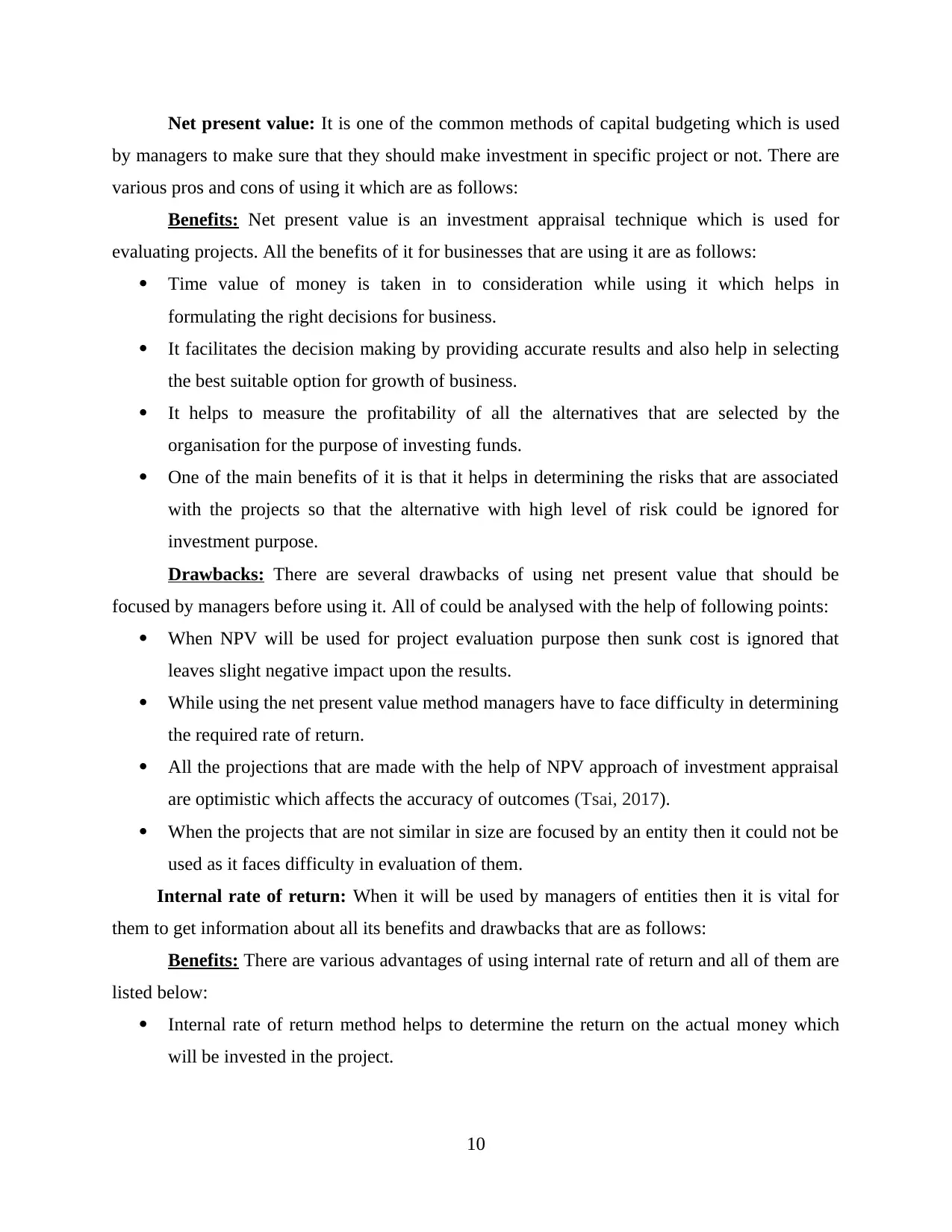
Net present value: It is one of the common methods of capital budgeting which is used
by managers to make sure that they should make investment in specific project or not. There are
various pros and cons of using it which are as follows:
Benefits: Net present value is an investment appraisal technique which is used for
evaluating projects. All the benefits of it for businesses that are using it are as follows:
Time value of money is taken in to consideration while using it which helps in
formulating the right decisions for business.
It facilitates the decision making by providing accurate results and also help in selecting
the best suitable option for growth of business.
It helps to measure the profitability of all the alternatives that are selected by the
organisation for the purpose of investing funds.
One of the main benefits of it is that it helps in determining the risks that are associated
with the projects so that the alternative with high level of risk could be ignored for
investment purpose.
Drawbacks: There are several drawbacks of using net present value that should be
focused by managers before using it. All of could be analysed with the help of following points:
When NPV will be used for project evaluation purpose then sunk cost is ignored that
leaves slight negative impact upon the results.
While using the net present value method managers have to face difficulty in determining
the required rate of return.
All the projections that are made with the help of NPV approach of investment appraisal
are optimistic which affects the accuracy of outcomes (Tsai, 2017).
When the projects that are not similar in size are focused by an entity then it could not be
used as it faces difficulty in evaluation of them.
Internal rate of return: When it will be used by managers of entities then it is vital for
them to get information about all its benefits and drawbacks that are as follows:
Benefits: There are various advantages of using internal rate of return and all of them are
listed below:
Internal rate of return method helps to determine the return on the actual money which
will be invested in the project.
10
by managers to make sure that they should make investment in specific project or not. There are
various pros and cons of using it which are as follows:
Benefits: Net present value is an investment appraisal technique which is used for
evaluating projects. All the benefits of it for businesses that are using it are as follows:
Time value of money is taken in to consideration while using it which helps in
formulating the right decisions for business.
It facilitates the decision making by providing accurate results and also help in selecting
the best suitable option for growth of business.
It helps to measure the profitability of all the alternatives that are selected by the
organisation for the purpose of investing funds.
One of the main benefits of it is that it helps in determining the risks that are associated
with the projects so that the alternative with high level of risk could be ignored for
investment purpose.
Drawbacks: There are several drawbacks of using net present value that should be
focused by managers before using it. All of could be analysed with the help of following points:
When NPV will be used for project evaluation purpose then sunk cost is ignored that
leaves slight negative impact upon the results.
While using the net present value method managers have to face difficulty in determining
the required rate of return.
All the projections that are made with the help of NPV approach of investment appraisal
are optimistic which affects the accuracy of outcomes (Tsai, 2017).
When the projects that are not similar in size are focused by an entity then it could not be
used as it faces difficulty in evaluation of them.
Internal rate of return: When it will be used by managers of entities then it is vital for
them to get information about all its benefits and drawbacks that are as follows:
Benefits: There are various advantages of using internal rate of return and all of them are
listed below:
Internal rate of return method helps to determine the return on the actual money which
will be invested in the project.
10
⊘ This is a preview!⊘
Do you want full access?
Subscribe today to unlock all pages.

Trusted by 1+ million students worldwide
1 out of 14
Related Documents
Your All-in-One AI-Powered Toolkit for Academic Success.
+13062052269
info@desklib.com
Available 24*7 on WhatsApp / Email
![[object Object]](/_next/static/media/star-bottom.7253800d.svg)
Unlock your academic potential
Copyright © 2020–2025 A2Z Services. All Rights Reserved. Developed and managed by ZUCOL.





